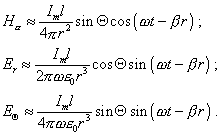| V.1 | 39 - 40 - 41 |
| On longitudinal electromagnetic waves | |
|
|
| 39 | |
 |
|
(Moreover, by the condition of the field calculation
r >> l , consequently, Proceeding from that, (2-3-10) has to take a normal form |
|
|
(33) |
As we can see, (33) describes the progressive wave; it
means that the longitudinal component of the field One would think: having determined such important characteristic, we can consider the Pointing vector for a longitudinal wave: |
|
| 40 | |
| However here we are running into a double complication
caused again by the invalid simplifications and omissions. First, if we try substituting
the corrected system (33) into the system of Maxwell equations, this will not work because
of phase shift by |
|
| in the left-hand part of the sum the uncompensated term | |
appears, and it must be equalised to zero with all consequences. Given the derivation of field equations, conducted by Kugushev and based on the standard field theory formalism, coincides in its technique with that conventional, the incorrectness of simplifications was caused not by the author's inattention but it was a compulsory action to retain the structure of the formalism based on Maxwell's equations. This conclusion can be corroborated simply by way of analysing the second pair of Maxwell's equations 41 |
|
| by analogy with the pair of Maxwell's equations | |
S econd, the vectors |
|
is true. The vector of the magnetic field strength |
|
and if |
|
